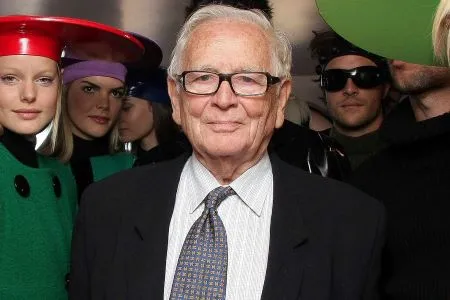
When we think of iconic figures who have truly shaped the fashion landscape, Pierre Cardin stands as a beacon of creativity and innovation. Known for his avant-garde designs and unrelenting passion for experimentation, Cardin wasn’t just a designer—he was a futurist who redefined the way we perceive style. His legacy extends far beyond the confines of the fashion industry, influencing art, culture, and business on a global scale. But who was this man, and how did he carve his name into the annals of history? Let’s explore his extraordinary journey.
Table of Contents
Early Life and Beginnings
Pierre Cardin’s Humble Beginnings:
Born Pietro Costante Cardin on July 2, 1922, in a small Italian town near Venice, Pierre Cardin’s early life was marked by simplicity and modesty. His parents, farmers who later relocated to France, instilled in him the values of hard work and determination. As a child, Cardin showed an innate talent for design and an interest in the arts, often sketching patterns and sewing small items.
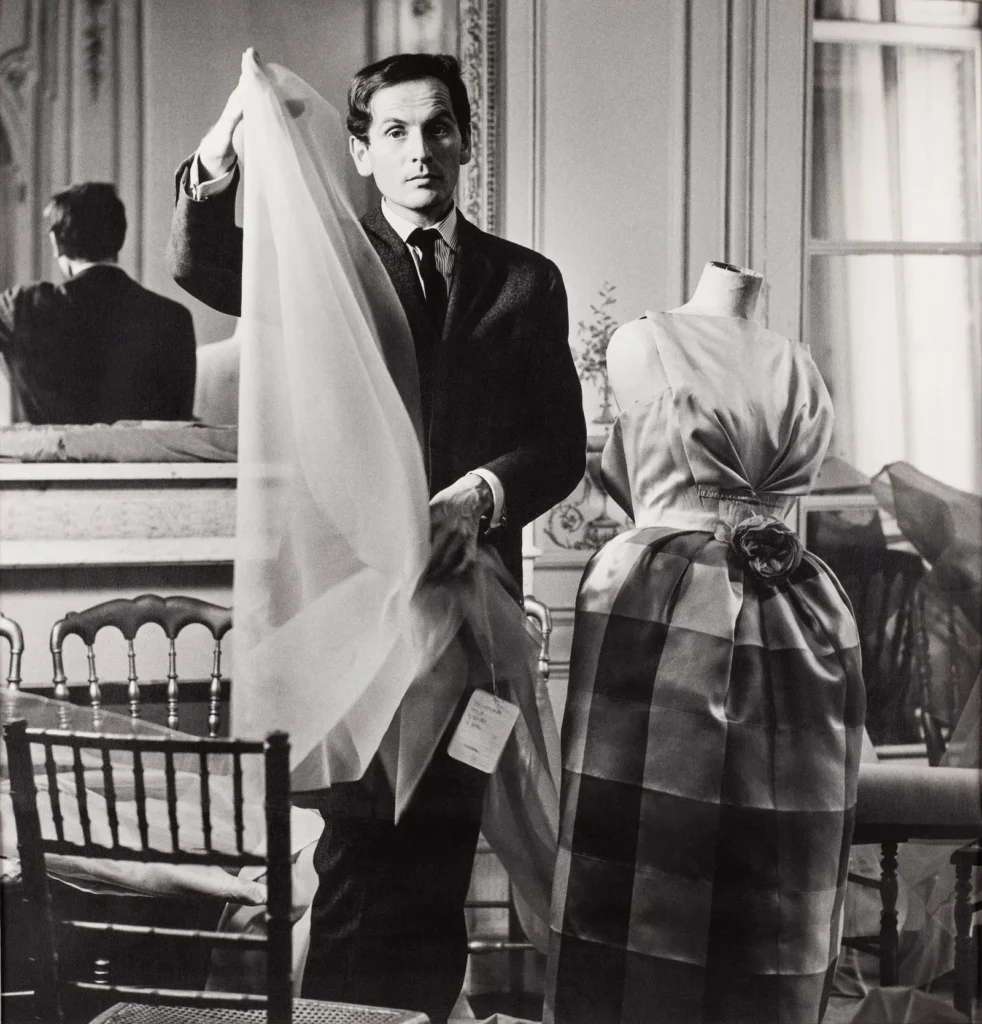
photo/vogue
Initial Steps Into the World of Fashion:
At just 14 years old, Cardin began his apprenticeship with a tailor in Saint-Étienne, France. This hands-on experience taught him the technical skills and craftsmanship that would later define his career. His journey to Paris in 1945 marked a turning point. He worked with renowned fashion houses like Paquin and Schiaparelli, eventually contributing to Christian Dior’s iconic “New Look” collection in 1947. This formative period laid the foundation for his meteoric rise in the fashion world.
Design Philosophy
Pierre Cardin’s design philosophy was deeply rooted in experimentation and futurism. Unlike many of his contemporaries who adhered to traditional forms, Cardin saw fashion as a medium for exploring the uncharted. He believed that clothing should not only be functional but also a work of art.
Geometry and Minimalism:
Cardin’s love for geometric shapes defined his work. He often played with circles, triangles, and rectangles, creating garments that looked more like sculptures than traditional attire. Minimalism was another key element of his philosophy. By focusing on clean lines and innovative cuts, he sought to highlight the essence of the design without unnecessary embellishments.
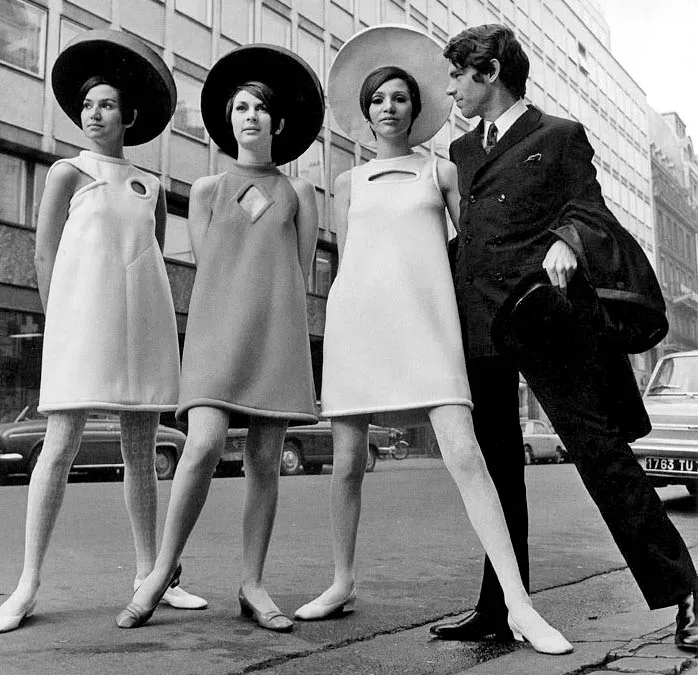
photo/sewingmachine
Fashion Beyond Gender and Norms
Cardin challenged societal norms by introducing unisex fashion long before it became mainstream. He believed that clothing should not be confined by gender and often designed pieces that could be worn by anyone. This forward-thinking approach reflected his commitment to inclusivity and creativity.
The Rise of Pierre Cardin
Establishing His Brand in Paris
By 1950, Cardin was ready to forge his path. He opened his fashion house in Paris, a bold move in a city teeming with established designers. His early collections were met with critical acclaim, thanks to their innovative use of structure and material. Cardin’s ability to blend traditional tailoring with futuristic concepts quickly set him apart.
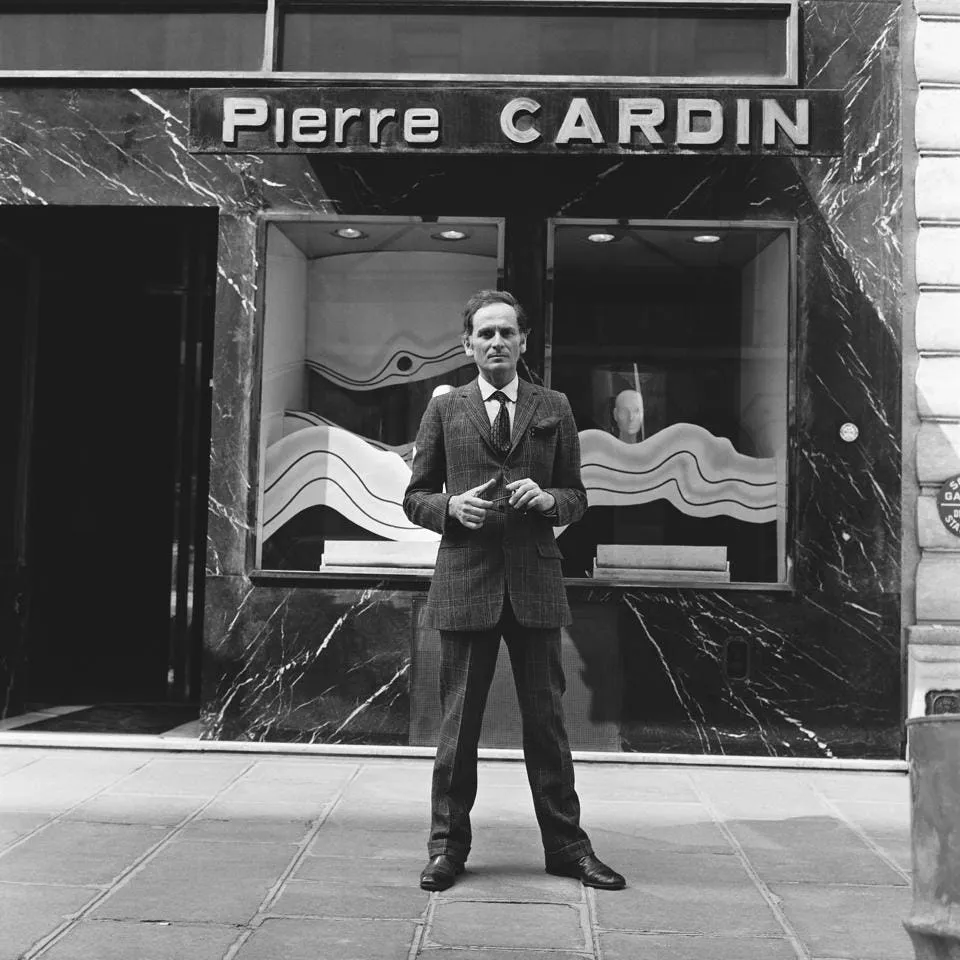
photo/forbes
Introduction of Prêt-à-Porter
Cardin broke new ground in 1959 by launching one of the first prêt-à-porter (ready-to-wear) collections. This move was revolutionary in an era dominated by haute couture, as it brought high fashion to everyday consumers. Cardin’s prêt-à-porter line blurred the lines between exclusivity and accessibility, democratizing style in a way few had dared before.
Notable Collections and Work
Space Age Collection (1960s)
Cardin’s Space Age collection in the 1960s was a groundbreaking moment in fashion. Inspired by the fascination with space exploration, this collection featured metallic fabrics, helmets, and futuristic silhouettes. It captured the imagination of a world looking towards the stars and solidified Cardin’s reputation as a designer ahead of his time.
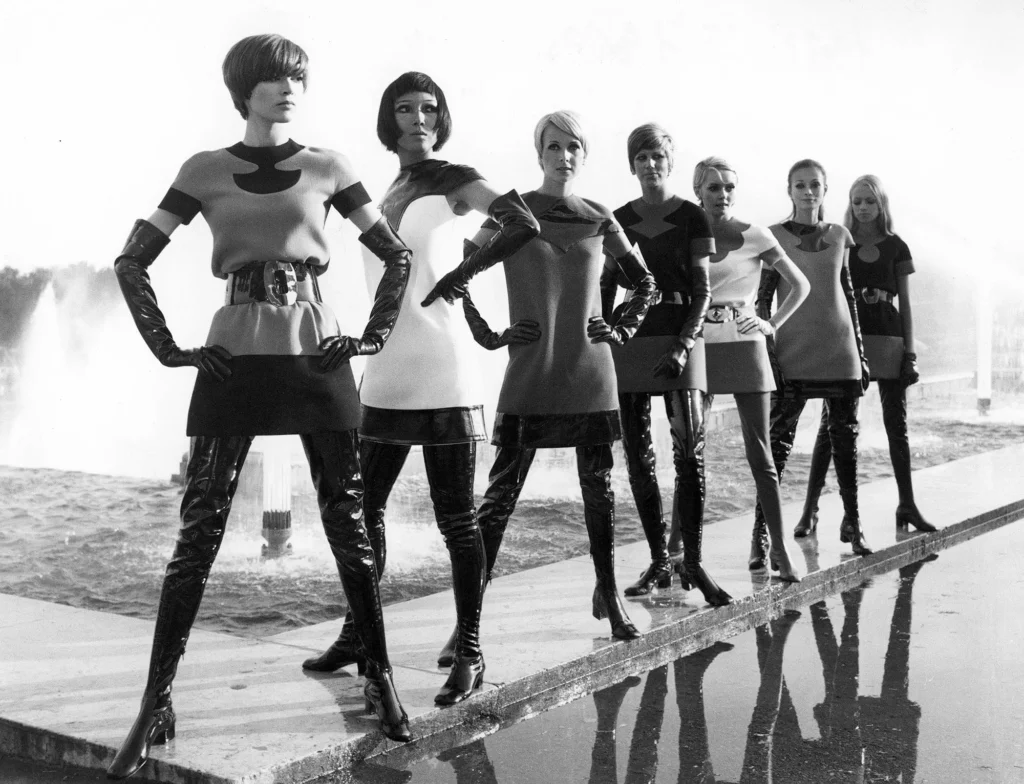
photo/thenewyorktimes
The Bubble Dress: A Revolutionary Design
In 1954, Cardin introduced the bubble dress, a design that became synonymous with his name. The dress featured voluminous, circular shapes that seemed to defy gravity, creating a playful yet sophisticated silhouette. It was a stark departure from the fitted, traditional styles of the time, signaling a shift towards more experimental fashion.
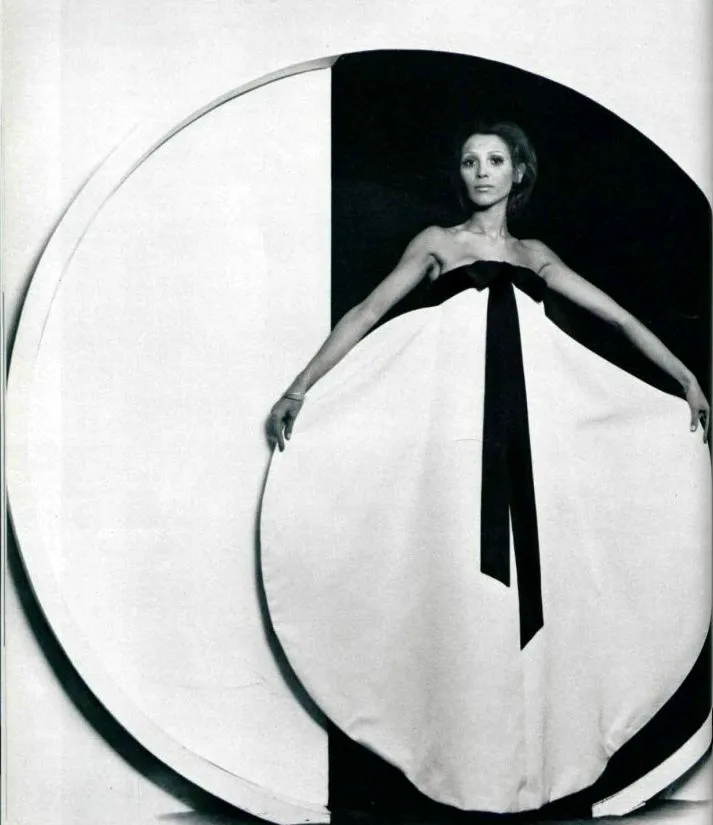
photo/formidablemag
Slim-Fit Suits for Men
Cardin revolutionized menswear by introducing slim-fit suits that emphasized a sleek and modern aesthetic. These suits became an essential part of men’s fashion and were famously worn by The Beatles, further cementing his influence on pop culture.
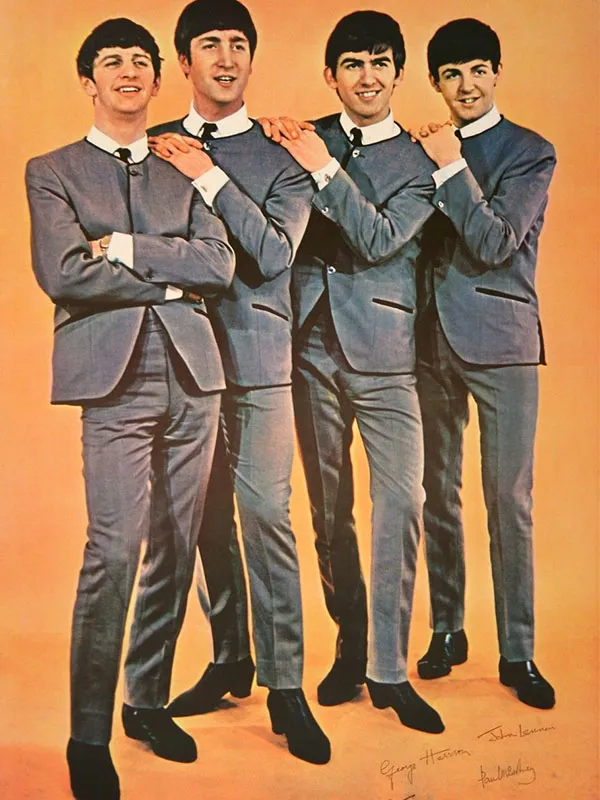
Beatles/Photo/wetcfashion.
Avant-Garde Costumes for Theater
Cardin’s contributions extended beyond fashion to theater and film. He had been an inspiration to design avant-garde costumes for plays like The Marriage of Figaro and movies such as Barbarella. These pieces showcased his versatility and ability to adapt his vision across different mediums.
Interesting Facts
- First Designer in China: In 1979, Pierre Cardin became the first Western designer to present a fashion show in China. This bold move marked the beginning of globalization in fashion.
- Over 800 Licenses Worldwide: Cardin’s licensing empire included everything from fashion and perfumes to furniture and even airplanes. His brand name appeared on an unparalleled range of products.
- Space Pioneer: Cardin was so fascinated by space that he once collaborated with NASA to design uniforms for astronauts, merging science and fashion in a truly unique way.
- Owned Maxim’s Restaurant: In 1981, Cardin purchased the famous Parisian restaurant Maxim’s and expanded it into a global luxury brand.
- Longevity in Fashion: Even in his 90s, Cardin continued to design, attend fashion shows, and oversee his business empire, proving that age is no barrier to creativity.
Louis Féraud: A Journey Through Fashion, Art, and Timeless Elegance
Breaking Boundaries
Fusion of Architecture and Fashion
Cardin’s love for geometric shapes and futuristic designs was deeply inspired by architecture. His garments often featured clean lines, bold patterns, and innovative materials, giving them a sculptural quality. Pieces like his space-age suits and modular dresses were as much works of art as they were wearable clothing.
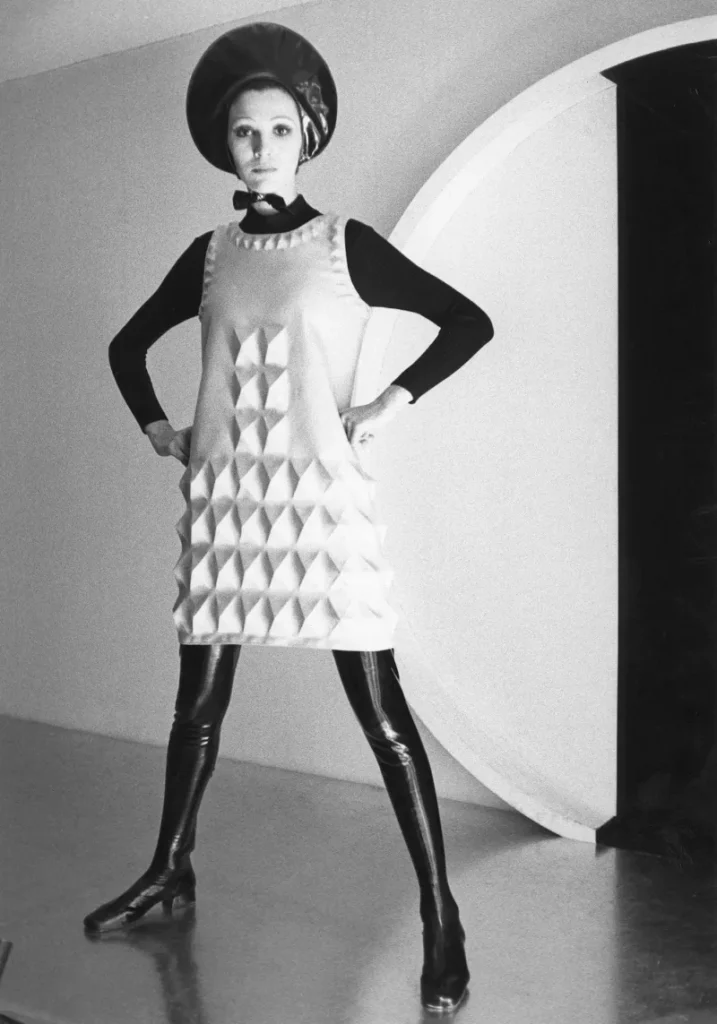
photo/irenebrination
Influence on Menswear and Unisex Fashion
Long before unisex fashion became a trend, Cardin was pushing boundaries. In the 1960s, he introduced slim-fit suits for men, which became a staple in modern menswear. His designs also embraced androgyny, with collections that blurred gender lines, challenging societal norms and paving the way for more inclusive fashion.
Legacy and Innovation
Impact on Future Generations: Cardin’s futuristic designs and business acumen inspired countless designers, including Jean Paul Gaultier and Issey Miyake. His willingness to experiment encouraged the industry to embrace bold, unconventional ideas.
Sustainability Before It Was Trendy: Cardin’s emphasis on quality craftsmanship and timeless designs aligned with sustainable principles long before they became mainstream. His work serves as a reminder that fashion can be both innovative and responsible.
Breaking Boundaries
Fusion of Architecture and Fashion: Cardin’s love for geometric shapes and futuristic designs was deeply inspired by architecture. His garments often featured clean lines, bold patterns, and innovative materials, giving them a sculptural quality. Pieces like his space-age suits and modular dresses were as much works of art as they were wearable clothing.
Influence on Menswear and Unisex Fashion: Long before unisex fashion became a trend, Cardin was pushing boundaries. In the 1960s, he introduced slim-fit suits for men, which became a staple in modern menswear. His designs also embraced androgyny, with collections that blurred gender lines, challenging societal norms and paving the way for more inclusive fashion.
The Business Genius
Expanding Into Licensing: Pierre Cardin was a pioneer of brand licensing, a strategy that allowed his name to appear on a wide range of products, from perfumes and accessories to furniture and even automobiles. By doing so, he built one of the most diversified fashion empires in history, making his brand a household name worldwide.
Creating a Global Empire: Cardin was among the first designers to enter markets outside of Europe, introducing his work to Asia, the Middle East, and South America. He understood the potential of globalization and tailored his designs to appeal to diverse cultures, ensuring his brand’s enduring popularity across continents.
Contributions to the Arts
Pierre Cardin as a Patron of the Arts: Cardin’s creativity wasn’t confined to fashion. He was a passionate patron of the arts, often collaborating with musicians, painters, and architects. His theatrical costume designs, including those for the iconic 1969 production of The Marriage of Figaro, showcased his versatility.
Restoring Château Lacoste:
In the 1980s, Cardin purchased Château Lacoste, a historic property in southern France. He restored the château and transformed it into a cultural hub, hosting exhibitions, concerts, and festivals. This endeavor highlighted his commitment to preserving heritage while fostering artistic expression.

Château de Lacoste/photo/wikipedia
Cultural Influence
How Pierre Cardin Shaped Pop Culture: Cardin’s designs were a staple in the wardrobes of cultural icons. From dressing The Beatles in their signature collarless suits to creating costumes for science-fiction films, his work was deeply intertwined with the zeitgeist of the 20th century.
Dressing Celebrities and Icons: Hollywood stars like Elizabeth Taylor, Brigitte Bardot, and Jacqueline Kennedy were often seen in Cardin’s creations. His ability to blend elegance with innovation made him a favorite among the elite, further solidifying his influence on global fashion.
Legacy and Innovation
Impact on Future Generations: Cardin’s futuristic designs and business acumen inspired countless designers, including Jean Paul Gaultier and Issey Miyake. His willingness to experiment encouraged the industry to embrace bold, unconventional ideas.
Sustainability Before It Was Trendy: Cardin’s emphasis on quality craftsmanship and timeless designs aligned with sustainable principles long before they became mainstream. His work serves as a reminder that fashion can be both innovative and responsible.
Challenges and Controversies
Criticism in the Fashion Industry: Cardin’s foray into mass production drew criticism from the haute couture community, which saw it as a dilution of exclusivity. However, Cardin remained unapologetic, believing in the democratization of fashion.
Managing an Expansive Brand: With over 800 licenses worldwide, managing his brand was no small feat. While this strategy brought immense success, it also posed challenges in maintaining quality and coherence across products.
Final Years and Passing
Continuing to Work Beyond Expectations: Even in his 90s, Cardin remained active, designing collections and overseeing projects. His dedication to his craft was a testament to his passion and drive.
Remembering a Legend: Pierre Cardin passed away on December 29, 2020, at the age of 98. His legacy continues to inspire, reminding the world of the power of vision and innovation.
Pierre Cardin at a Glance
| Category | Details |
|---|---|
| Introduction | Pierre Cardin was an avant-garde designer and futurist who redefined fashion, influencing art, culture, and business globally. |
| Early Life and Beginnings | Humble Beginnings: Born Pietro Costante Cardin on July 2, 1922, in Italy. Grew up in modest surroundings. Early Steps: Began an apprenticeship at 14 with a tailor in Saint-Étienne, France. Worked with Paquin, Schiaparelli, and Christian Dior, contributing to the “New Look” collection in 1947. |
| Design Philosophy | – Focused on experimentation and futurism. – Geometry and Minimalism: Used clean lines and bold shapes, emphasizing innovation. – Advocated for fashion beyond gender, introducing unisex designs. |
| The Rise of Pierre Cardin | – Established his Paris fashion house in 1950. – Introduced prêt-à-porter (ready-to-wear) in 1959, democratizing high fashion. |
| Notable Collections and Work | – Space Age Collection (1960s): Featured metallic fabrics and futuristic silhouettes inspired by space exploration. – Bubble Dress (1954): Circular, voluminous design breaking conventional styles. – Slim-Fit Suits for Men: Revolutionized menswear, famously worn by The Beatles. – Costumes for Theater and Film: Designed for plays and movies like Barbarella. |
| Interesting Facts | – First Western designer to showcase in China (1979). – Owned over 800 licensing agreements worldwide. – Collaborated with NASA on astronaut uniforms. – Purchased and expanded Maxim’s Restaurant. – Continued designing into his 90s. |
| Breaking Boundaries | – Fusion of Architecture and Fashion: Garments often resembled sculptures, inspired by architecture. – Influence on Unisex Fashion: Introduced gender-neutral designs and slim-fit suits. |
| The Business Genius | – Pioneered brand licensing, expanding into perfumes, furniture, and more. – Established a global fashion presence in Asia, the Middle East, and South America. |
| Contributions to the Arts | – Patron of the arts, collaborating with musicians and architects. – Restored Château Lacoste into a cultural hub for exhibitions and festivals. |
| Cultural Influence | – Styled cultural icons like The Beatles, Elizabeth Taylor, and Brigitte Bardot. – Influenced pop culture through futuristic and iconic designs. |
| Legacy and Innovation | – Inspired future designers like Jean Paul Gaultier and Issey Miyake. – Advocated sustainability through timeless designs. |
| Challenges and Controversies | – Criticized by haute couture for mass production. – Faced challenges in maintaining quality across diverse licensed products. |
| Final Years and Passing | – Remained active in design even in his 90s. – Passed away on December 29, 2020, at 98 years old. |
Conclusion
Pierre Cardin was more than just a designer; he was a visionary who redefined the boundaries of fashion, art, and business. His legacy is a testament to the enduring power of creativity and the impact of daring to be different.
FAQs
1. What is Pierre Cardin best known for?
Pierre Cardin is best known for his futuristic designs, including the bubble dress, and for pioneering prêt-à-porter fashion.
2. How did Pierre Cardin influence modern fashion?
He broke traditional norms by introducing ready-to-wear collections, unisex designs, and geometric aesthetics inspired by space-age themes.
3. What were Pierre Cardin’s most iconic designs?
The bubble dress, slim-fit menswear, and his space-age collections are some of his most iconic works.
4. Did Pierre Cardin focus on sustainability?
Yes, Cardin emphasized timeless designs and quality craftsmanship, promoting a sustainable approach to fashion.
5. Where can I learn more about Pierre Cardin’s work?
You can explore his legacy through museums, exhibitions, books, and documentaries dedicated to his life and creations.
One thought on “Pierre Cardin: The Fashion Maverick Who Embraced Futurism”